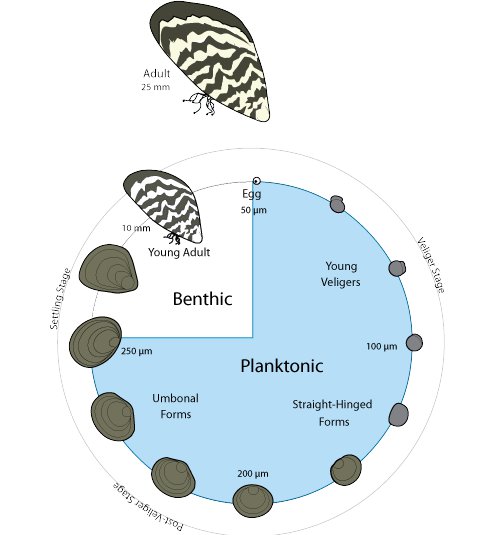The Science
The Most Costly Pests ever Introduced to America's Freshwaters
The Science
The Most Costly Pests ever Introduced to America's Freshwaters
The Science
The Most Costly Pests ever Introduced to America's Freshwaters
Zebra and Quagga Mussels are alien to North America but have invaded many of our waters.

Once established, invasive mussels will be here forever.
Zebra and Quagga Mussels are freshwater, bivalve mollusks that typically have a dark and white (zebra-like) pattern on their shells. They are alien to North America but have invaded many of our waters.
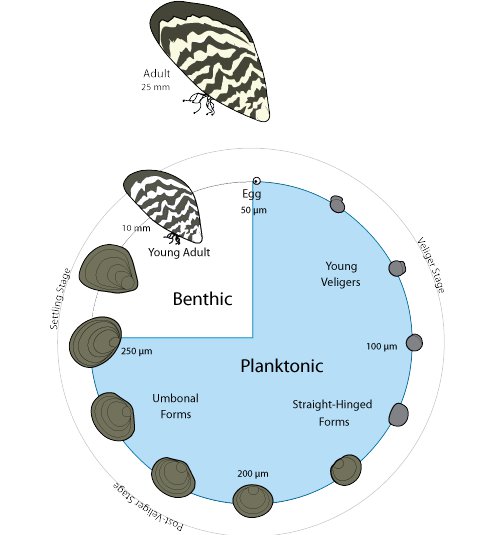
Impacts to tourism, hydropower, and infrastructure (irrigation systems, power facilities, and municipal water supply and treatment) could cost more than $95 million a year.

Once established, invasive mussels will be here forever. They are virtually impossible to remove. The ONLY solution is PREVENTION.
Background Information

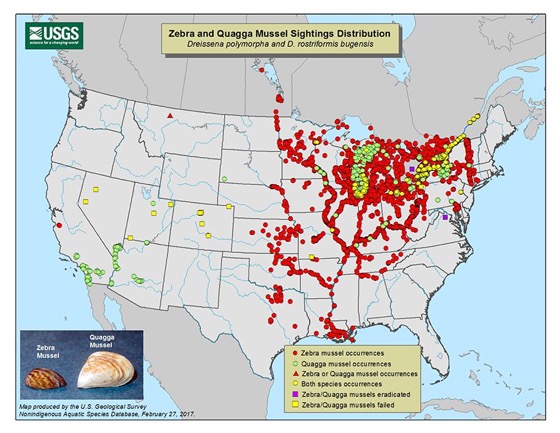
There are two species of Dreissena, both non-native, in North America: Dreissena polymorpha, commonly called "Zebra Mussels" and Dreissena rostiformis bugensis, commonly called "Quagga Mussels". Despite some minor appearance and ecological differences, the species are very similar and pose a significant threat to our waters.
Both species, Zebra Mussels and Quagga Mussels, in general, are usually about an inch or less long, but may be larger. Zebra and Quagga mussels attach to hard substrates. much like marine (saltwater) mussels but unlike any native freshwater bivalve. They are often found in clusters.
Zebra and Quagga mussels are native to Eurasia. Until the mid 1980s there were no zebra mussels in North America. Quickly that changed when they were inadvertently introduced into waters near the Great Lakes region. It is suspected that zebra mussels hitched a ride in ballast water tanks of commercial ships. Zebra Mussels were first discovered in the United States in Lake St. Clair near Detroit, Michigan in 1988. Since the '80s, zebra mussels have spread, unchecked by natural predators, throughout much of the eastern United States. They currently infest much of the Great Lakes basin, the St. Lawrence Seaway, and much of the Mississippi River drainage system. The have spread up the Arkansas River into eastern Oklahoma. Quagga mussels invaded North America later than zebra mussels and have been confirmed in fewer waters, including the Great Lakes, the St. Louis area and now in the Lower Colorado River. In November 2016, state officials announced the first documented presence of zebra and quagga mussels in Montana, after positive tests at sites in the Missouri River system (in Tiber Reservoir, and “suspect” detections in Canyon Ferry Reservoir).
When they are present in North American waters, they are usually millions of them. Zebra/Quagga Mussels are what scientists and engineers call "biofoulers" that block pipes in municipal and industrial water systems, requiring millions of dollars annually to treat. Zebra Mussel densities have been reported to be over 700,000 individuals per square meter in some facilities in the Great Lakes area. They produce microscopic larvae that float freely in the water column, and thus can pass by screens installed to exclude them. Monitoring and control of Zebra and Quagga Mussels costs millions of dollars annually.
Zebra/Quagga Mussels also negatively impact aquatic ecosystems, harming native organisms (including already imperiled indigenous mussels). In huge numbers, they out-compete other filter feeders, starving them. They adhere to all hard surfaces, including the shells of native mussels, turtles, and crustaceans. Zebra/Quagga mussels actively feed on green-algae and may increase the proportion of foul-smelling blue-green algae in water systems.
Background Information


There are two species of Dreissena, both non-native, in North America: Dreissena polymorpha, commonly called "Zebra Mussels" and Dreissena rostiformis bugensis, commonly called "Quagga Mussels". Despite some minor appearance and ecological differences, the species are very similar and pose a significant threat to our waters.
Both species, Zebra Mussels and Quagga Mussels, in general, are usually about an inch or less long, but may be larger. Zebra and Quagga mussels attach to hard substrates. much like marine (saltwater) mussels but unlike any native freshwater bivalve. They are often found in clusters.
Zebra and Quagga mussels are native to Eurasia. Until the mid 1980s there were no zebra mussels in North America. Quickly that changed when they were inadvertently introduced into waters near the Great Lakes region. It is suspected that zebra mussels hitched a ride in ballast water tanks of commercial ships. Zebra Mussels were first discovered in the United States in Lake St. Clair near Detroit, Michigan in 1988. Since the '80s, zebra mussels have spread, unchecked by natural predators, throughout much of the eastern United States. They currently infest much of the Great Lakes basin, the St. Lawrence Seaway, and much of the Mississippi River drainage system. The have spread up the Arkansas River into eastern Oklahoma. Quagga mussels invaded North America later than zebra mussels and have been confirmed in fewer waters, including the Great Lakes, the St. Louis area and now in the Lower Colorado River. In November 2016, state officials announced the first documented presence of zebra and quagga mussels in Montana, after positive tests at sites in the Missouri River system (in Tiber Reservoir, and “suspect” detections in Canyon Ferry Reservoir).
When they are present in North American waters, they are usually millions of them. Zebra/Quagga Mussels are what scientists and engineers call "biofoulers" that block pipes in municipal and industrial water systems, requiring millions of dollars annually to treat. Zebra Mussel densities have been reported to be over 700,000 individuals per square meter in some facilities in the Great Lakes area. They produce microscopic larvae that float freely in the water column, and thus can pass by screens installed to exclude them. Monitoring and control of Zebra and Quagga Mussels costs millions of dollars annually.
Zebra/Quagga Mussels also negatively impact aquatic ecosystems, harming native organisms (including already imperiled indigenous mussels). In huge numbers, they out-compete other filter feeders, starving them. They adhere to all hard surfaces, including the shells of native mussels, turtles, and crustaceans. Zebra/Quagga mussels actively feed on green-algae and may increase the proportion of foul-smelling blue-green algae in water systems.
General Biology
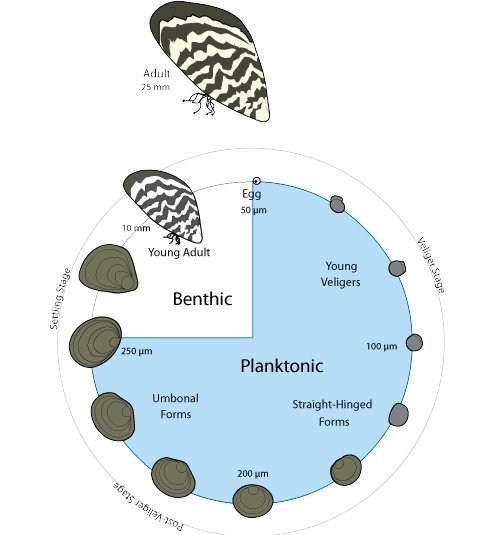
Species Names
Size
Lifespan
Reproductive Potential
Life Cycle
Impacts
Frequently Asked Questions

- Short Answer: Not Much
- These are two species within the same genus Dreissena
- Zebra Mussels invaded North America First (in mid-1980s). Quagga Mussels invaded a few years later (1989).
- There are morphological differences, but they are subtle
- There are ecological differences, but more research is needed on North
American quagga mussels to assess these differences
- The practical implications of zebra and quagga mussels are essentially
identical
Short Answer: Between 1-30° C (33-86° F)Heat Tolerance
Cold Tolerance
Temperature Preference
Short Answer: Algae and bacteria in the water column
Short Answer: They have no natural predators in North America
Short Answer: At any depth, but quaggas can be found in deeper water
Short Answer: They are, but most Europeans have been dealing with them for over 200 years. Their industrial facilities were designed with these in mind.
Short Answer: Larvae flow downstream. Adults attach to
recreational boats and equipment (anchors, bait buckets, etc).
Short Answer: Educate boaters and other water recreationists.
other water body:
came in contact with water.
the motor.
Frequently Asked Questions

- Short Answer: Not Much
- These are two species within the same genus Dreissena
- Zebra Mussels invaded North America First (in mid-1980s). Quagga Mussels invaded a few years later (1989).
- There are morphological differences, but they are subtle
- There are ecological differences, but more research is needed on North
American quagga mussels to assess these differences
- The practical implications of zebra and quagga mussels are essentially
identical
Short Answer: Between 1-30° C (33-86° F)Heat Tolerance
Cold Tolerance
Temperature Preference
Short Answer: Algae and bacteria in the water column
Short Answer: They have no natural predators in North America
Short Answer: At any depth, but quaggas can be found in deeper water
Short Answer: They are, but most Europeans have been dealing with them for over 200 years. Their industrial facilities were designed with these in mind.
Short Answer: Larvae flow downstream. Adults attach to
recreational boats and equipment (anchors, bait buckets, etc).
Short Answer: Educate boaters and other water recreationists.
other water body:
came in contact with water.
the motor.
General Biology
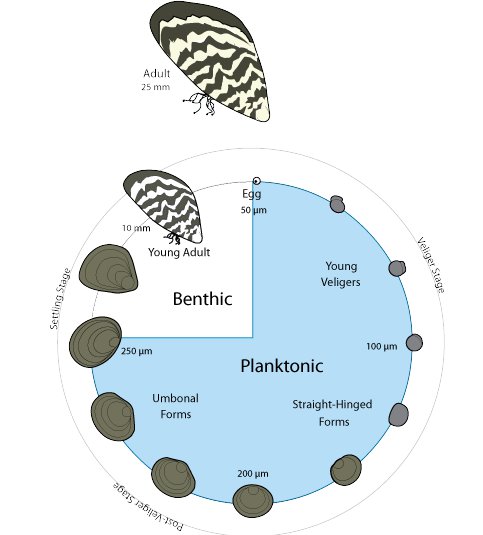
Species Names
Size
Lifespan
Reproductive Potential
Life Cycle
Impacts
Frequently Asked Questions

- Short Answer: Not Much
- These are two species within the same genus Dreissena
- Zebra Mussels invaded North America First (in mid-1980s). Quagga Mussels invaded a few years later (1989).
- There are morphological differences, but they are subtle
- There are ecological differences, but more research is needed on North
American quagga mussels to assess these differences
- The practical implications of zebra and quagga mussels are essentially
identical
Short Answer: Between 1-30° C (33-86° F)Heat Tolerance
Cold Tolerance
Temperature Preference
Short Answer: Algae and bacteria in the water column
Short Answer: They have no natural predators in North America
Short Answer: At any depth, but quaggas can be found in deeper water
Short Answer: They are, but most Europeans have been dealing with them for over 200 years. Their industrial facilities were designed with these in mind.
Short Answer: Larvae flow downstream. Adults attach to
recreational boats and equipment (anchors, bait buckets, etc).
Short Answer: Educate boaters and other water recreationists.
other water body:
came in contact with water.
the motor.


